How the ‘green’ minerals boom is threatening southwest Western Australia’s old growth forests
Raiding the forests to save the planet? The majestic stands of southwest Western Australia face a rapidly growing threat – from bauxite mining and the rush for ‘green’ minerals.
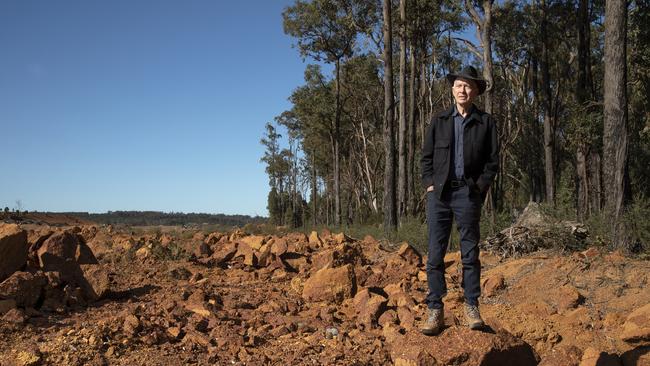
Down the road from Kingsley Dixon’s property a massive bulldozer has ripped up the leafy floor of a jarrah forest, like a demolition crew pulling the last length of carpet from a condemned house. The bulldozer’s job is to expose resource riches lying beneath the trees – marble-sized pebbles of bauxite. But first an entire forest and its contents must be cleared. Trees – some hundreds of years old – are felled, and all understorey is piled up and burned. Then topsoil is stripped and stockpiled while a layer of bauxite 5m deep is dug up and carted away in trucks, to be refined into aluminium.
We pull up at a locked gate a short distance from Dixon’s property near Waroona, an 80-minute drive southeast of Perth. He stands in front of a sign: Restricted area, Alcoa Mining Operation, Do not enter. “Beyond this gate is state forest that belongs to you and me, yet its use is essentially dictated by a multinational,” says Dixon. “And you have to mine large areas of it to get the quantity of alumina.”
Most of the jarrah forests in the southwest corner of Western Australia have bauxite mining leases over them. An aerial view of the vast green corridor, stretching 200km north and south of Perth, reveals a lace-like network infiltrating the forest – bare earth clearings linked by wide ribbons of access roads and topsoil depots that more than double the footprint of the actual mined strips.

In the days when loggers went in, big trees were cut down but the forest floor remained. That era of timber extraction is ending – the WA government will ban commercial logging in native forests by 2024. When Premier Mark McGowan made the announcement, he said it was due to “the ever-increasing impacts of climate change, the importance of maintaining biodiversity and forest health, the need for carbon capture and storage, and declining timber yields”.
Meanwhile, the miners’ activities are only set to increase, their quest for key metals poised to extend deeper into the forest. And it doesn’t stop with bauxite. The wandoo woodlands at Julimar state forest are an easy 90-minute drive northeast of Perth, a popular recreation spot for campers and hikers. Beneath the forest floor lie tantalising ore bodies of nickel, copper, cobalt, platinum and palladium. All are key ingredients in the “green” revolution, urgently sought by makers of solar batteries, electric cars and catalytic converters that reduce toxic car exhaust emissions.
“The world’s consumption of these metals is going up exponentially and there’s only a dozen or so occurrences like this on the planet,” says Chalice Mining CEO Alex Dorsch, whose company identified Julimar’s “green” metals potential, sending share markets and governments into a frenzy. “We’re blessed in Western Australia to have this fantastic geology,” he says, adding that locals need to understand they face a new “green” mineral mining boom. This time, the boom won’t be out of sight in the remote Pilbara iron ore province thousands of kilometres to the north, but within a 100km radius of Perthites’ backyards. “There are dozens of companies looking now at the west and southwest for minerals,” he says.
As one of the state’s most senior plant ecologists, Kingsley Dixon knows what the impact will be on the forest. The director of the ARC Centre for Mine Site Restoration at Curtin University, he is also one of Australia’s foremost experts who has helped rewrite international standards on the way mine sites are restored. “It’s one of the toughest ecological projects on the planet,” he says, leaning on the gate to Alcoa’s operation. “There have been few cases of successful large-scale restoration anywhere.” He motions behind him. “This is the largest strip-mining activity in a global biodiversity hotspot. Yet we are in a sophisticated Western country.”

Dixon is surprised that so few people know the extent of forest-clearing on Perth’s doorstep. Even fewer know about the historic deal done back in 1961, when a cash-strapped West Australian government signed a state agreement that handed Alcoa access to the forest until 2045. It was a bonanza for the miner – access to 12,600 sq km, bigger than greater Sydney. The area was reduced in 1994 to the current 7130 sq km, but by then Alcoa had been joined by a second company, Worsley Alumina (now owned by South32) which began mining bauxite in 1974. Their combined long-term leases cover almost 10,000 sq km.
Along with entry to vast stands of public forest, including water catchments, their agreements have unique terms – only the state development minister, not the forest department, has direct influence over mining activities. Park boundaries and A-class reserves can be redrawn to accommodate mining, and companies can fence and block access to the public estate.
Veteran bushwalker David Osborne regularly hikes along public forest trails that lie as close as 50km from Perth’s city skyline. The vista of wildflowers and eucalypt woodlands may seem endless, but recently Osborne climbed a hill and spotted a wide clearing of felled forest ahead. “They’ll be operating for 30 years in that area,” says Osborne, a geologist who is also president of bushwalking club HikeWest. “They’ll put in haul roads the size of a four-lane freeway.”
The state’s 1000km hiking trail, the Bibbulmun Track, winds through much of the picturesque forest country; it has been rerouted a number of times as a result of mining. “Some of the track goes through protected areas, but that’s only 15 per cent of the forest,” says Osborne. “The rest can be mined. It’s incredible really.”
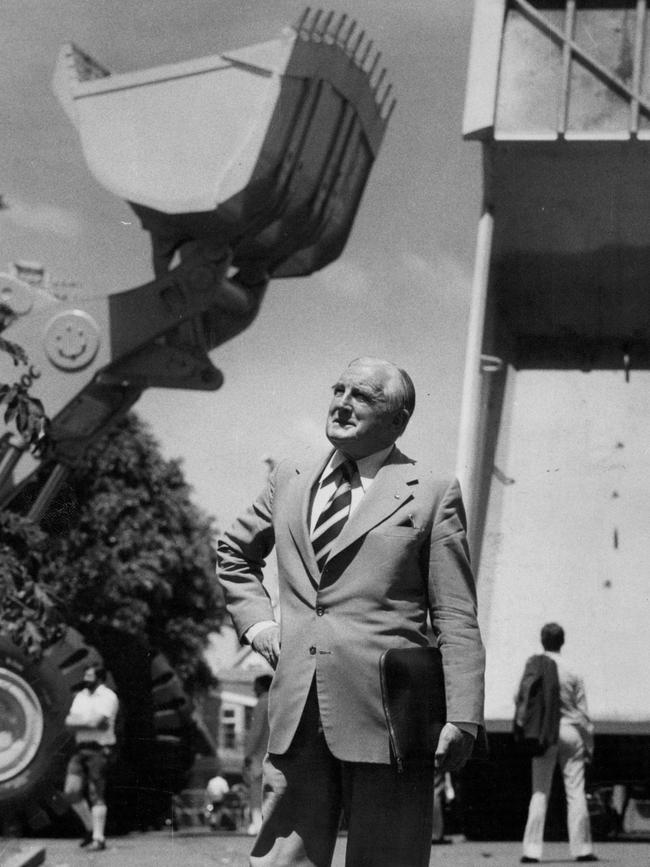
Mining the forest has been a discreet and incremental activity, often hidden behind “green” tree corridors and escalating over time in rarely publicised statistics. When bauxite mining started, then premier Sir Charles Court assured parliament that less than 12ha of forest a year would be sacrificed. Official figures show that up to December 2019 Alcoa and South32 alone have cleared 31,170ha for mining activity – but conservationists say that means 100,000ha of forest has been fragmented.
Alcoa’s Huntly site is now the second-largest bauxite mine in the world and supplies three WA alumina refineries. South32’s Worsley Alumina is also a major bauxite mining and alumina refining operation, extracting ore in state-owned forest 130km southeast of Perth. Both companies are major employers, with 4000 workers at Alcoa and 2000 with South32; Alcoa says it paid $714 million in wages last year, while South32 says it injects more than $1 million a day into the local economy.
Both companies have applied to expand their footprint and increase their rate of mining, jointly requiring another 11,000ha of clearing. And another player, Rio Tinto, has applied for 10 exploration permits extending across much of the Darling Range, the tree-covered upland visible from any tall building in Perth. Rio’s proposed tenements form a patchwork quilt effect on maps – many overlap with areas already earmarked by rivals Alcoa and South32 for bauxite, but Rio’s quest is to find lithium, the electric-battery raw material, and other “green” minerals.
Alcoa claims that only 8 per cent of its vast lease area will ultimately be mined, and that 77 per cent of areas mined so far have been rehabilitated. It has committed not to mine in areas of high conservation value. But its main claim – and that of South32 – is that what it destroys, it grows back in a “forest-to-forest” approach. Alcoa’s 2020 Sustainability report states that it has earned “the credibility and trust to mine bauxite in two of the most sensitive areas on the planet – the Brazilian Amazon and the Jarrah forest in Western Australia”.
Since 1988, after failed attempts at plantation- type regrowth, Alcoa has replanted its mine sites with native seeds and plants; last year, it planted 550,000 jarrah seedlings. It also states that it is “the first mining company in the world to achieve 100 per cent plant species richness in rehabilitated mine site areas”. This was achieved by scientific techniques such as a tissue culture laboratory “that produces over 100,000 plants each year… including the 20 per cent of species that are ‘recalcitrant’ [difficult to cultivate and germinate].”
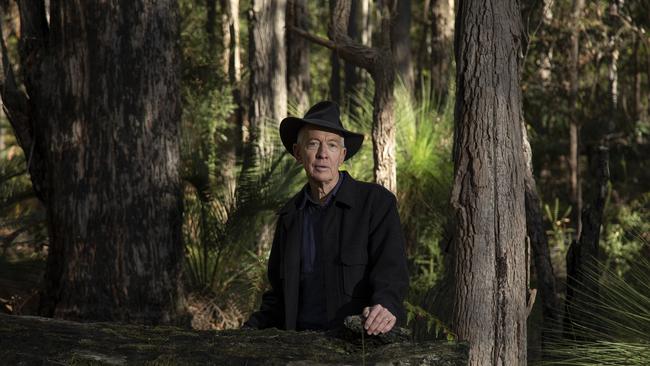
The word “recalcitrant” goes to the heart of Dixon’s claim that miners cannot simply “regrow” the forest. As the author of 400 scientific papers on Western Australia’s unique plants, he says the southwest, including its forests, contains more than 8000 native species – a stunning richness that contrasts with only 1500 species for the entire United Kingdom. Dixon says half the local species are found nowhere else on Earth and many of them are difficult to grow: “If the mining companies claim they can replace the forest and all its species, it needs to demonstrate that the forest destroyed is replaced like-for-like.”
He says the UK’s Royal Botanic Gardens at Kew worked with him recently to confirm that two orchid species found on the edge of recently mined areas were new to science. “We are still finding new species in the jarrah forest and it is naive to think areas can be adequately surveyed ahead of clearing. Potentially these two undetected species will face a king hit with the expansion of one of Alcoa’s programs. They have taken an old growth forest back to ground zero, which has never happened before in its evolution,” he says. “Entire fungal networks are destroyed by clearing, especially if topsoil is piled up and turned into a compost heap. Some seeds germinate but you might get one plant to regrow when there should be 50. And the diversity of species plummets.”
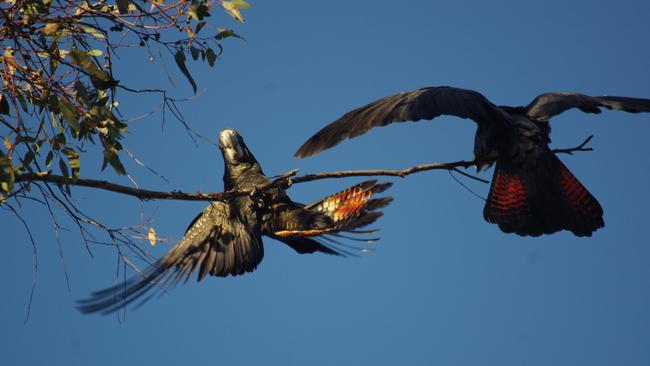
He recently took a group from Birdlife International to inspect rehabilitated mine sites. “We went first to the old forest and saw a great mixture of ancient trees, some 300 to 400 years old, with nearby trees hosting nesting cockatoos. There were different aged jarrahs coming through, a complex understorey with species found in some parts but not in others. Leaf litter, fabulous root systems and a great sense of resilience in the system.” They moved on to a stand of rehabilitated forest in a former mine pit. “There were missing orchids, rushes, sedge and native blueberry families, an almost total lack of annual flora that brings an eruption of colour. The group said, ‘It’s all gone silent, where are the birds?’”
Dixon sits on the Threatened Species Scientific Committees at federal and state level. “The principal threat to forest birds like Carnaby’s Cockatoo, Baudin’s and Red-tailed Black Cockatoo is the felling of suitable roosting and nesting trees. Trees that are up to 300 to 400 years old – how can you ‘restore’ them? It’s an oxymoron. You will only get them back in 300 to 400 years’ time.”
Then comes a candid admission. Dixon once supported Alcoa’s restoration efforts, and even conducted their research as a senior scientist at Kings Park Botanic Gardens in the late ’80s and ’90s. Alcoa paid for the state-of-the-art plant laboratory. “I’m quoted back in the 1990s saying, ‘Regrettable as bauxite mining is, we’ve got the best company doing it’. We were working with Alcoa researching seed dormancy. We went to their mine sites and the footprint seemed small. There was a wonderful research team that we were fully engaged with. We thought at the time that the jarrah forest was inexhaustible, and that nature was boundlessly resilient. All was patently untrue and we had no idea that the company was aiming to double their annual clearing.”
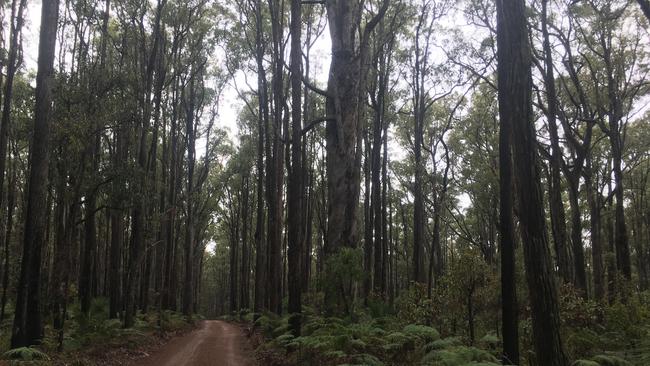
“We’re cursed to be blessed with rare minerals,” says Jennie Wise, community leader of a forest defenders’ group in her hometown of Dwellingup, 100km south of Perth. Wise and her husband made the treechange a dozen years ago to live in a town proud of its nature tourism. The Dwellingup Trails and Visitor Centre, partly paid for by Alcoa, urges visitors to “lace up your hiking boots and follow the bushwalking trails… As evening falls, the pristine jarrah forests are the perfect backdrop to pitch a tent beneath a canopy of stars.” An interactive display, installed by Alcoa, describes “how our operations can coexist with other land uses, such as recreational tracks and trails that are near mining operations”.
Yet it’s an uneasy coexistence. “If you go a few metres off the Bibbulmun Track you encounter a moonscape,” says Wise. “We’re requesting a mining exclusion zone around the town.”
Alcoa’s expansion plans require mining on another 8700ha of nearby land, and some of Rio Tinto’s tenements would close in on Dwellingup. “The proposals would mean coming up to within a few hundred metres of people’s property, and it also encompasses some of our most precious forests,” says Wise. She and her neighbours penned some of the 1500 submissions lodged in court against Rio’s plans last month. “Enough is enough.”
Yet Wise understands why the historic deals with mining companies were done. “We had no money as a state back in the 1960s, and bauxite mining was a huge bonus. So they made a generous state agreement, and many people were happy to have jobs. I just took it for granted that the forest would always be there.”
The debate about Western Australia’s forests is forging some odd new alliances. Where once the greenies and timber industry were at loggerheads, they are now uniting to challenge the state’s environmental management.
McGowan’s ban on forest logging exempts “clearing for approved mining operations”; it means the forest products sector may have to rely on mining clear-felling to access native hardwood timber. A new Forest Management Plan is being drawn up for the next decade but it does not address the impact of mining. “It’s ignoring the elephant in the room,” says Frank Batini, a retired forester, adjunct professor at Murdoch University and spokesperson for Forestry Australia. “If you don’t even discuss mining bauxite, what’s the point?” Batini says his industry has been warning about the rise of forest mining since 1980, “and now mine clearing is up to 1000ha a year, which impacts a further 2000ha”. He says Alcoa’s claim that it will excavate 8 per cent of its lease area ignores the wider impact of haul roads and dumpsites. “And they will end up taking out 90 per cent of the high quality forest. So which figure do you focus on?”
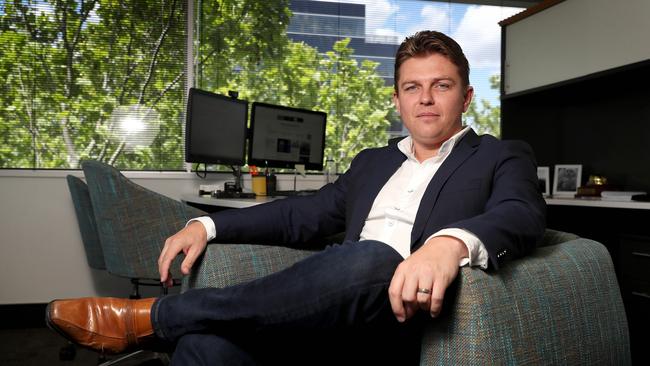
Like a fresh clearing on a leafy track, a new pitchabout forest mining is coming into view on the business pages and in company prospectuses. Raiding the forest is being heralded as a way of saving the planet. It’s an argument Chalice Mining’s Dorsch adopts with ease and seeming conviction. “Conservation and biodiversity are important, but we believe that taking the metals from the ground and putting them in electric vehicles would be a net positive for the environment. If we’re serious about decarbonising, about producing enough electric vehicles, we’re going to need to scale up rare metals by a factor of six,” he adds, quoting the International Energy Agency. “Even the forests of Western Australia are vulnerable to climate change… We must have the metals produced from somewhere.”
With the blessing of the state government, Chalice’s exploration drills are poised to cross into Julimar’s 29,000ha, A-class conservation reserve. Chalice’s prospective find, if mined, would mean partial destruction of a remnant ancient wandoo forest that shelters several threatened species. “But we won’t be like the bauxite miners… What we have is a different proposition,” says Dorsch. “Bauxite strip mining has a very large footprint that clears thousands of hectares of forest. We’d be far smaller than a bauxite mine.” He says Chalice could “replace” forest loss by replanting nearby land cleared decades ago by farmers. “The best place to extract minerals is here,” Dorsch argues. “We’ve made huge leaps forward in terms of addressing biodiversity and environmental impact, and WA is viewed as the high benchmark.” Julimar’s fate was sealed by mining decisions made decades ago, he adds. “Part of Alcoa’s state agreement covers the southern part of Julimar state forest, so Alcoa could start strip mining if they so choose.”

The quickening pace of exploration means compromise may be hard to find. Environment and climate action minister Reece Whitby says WA “is host to several export industries critical to the local and national economies, including those which are central to global decarbonisation efforts.” But he adds “it is a priority these industries co-exist harmoniously with the surrounding environment”. That may amount to putting more forest in conservation reserves and imposing strict boundaries so that strip mining “doesn’t creep up to our front doors”, as one pundit put it.
One obvious argument may have been lost: that native forests themselves are a weapon against climate change. Jess Beckerling from the WA Forests Alliance says WA’s forests are drawing down carbon in the atmosphere and storing it securely. “With so much damage already done across the southwest, what remains of our forests is absolutely vital for climate and biodiversity. We can’t mine our way out of the problems we’ve created for ourselves. We have to shift our consumption habits so we don’t mine everything in sight.”
The international drafting panel that Dixon sits on will soon launch a set of new global mining rehabilitation standards. “What it will do is provide Alcoa and South32 with a scorecard they can use,” he says. “But we’ve been very clear that you cannot invoke restoration as the reason for destroying whole ecosystems.” In other words, “we’ll grow it back” will no longer be a credible defence.
“We seem to be in a twilight zone in Western Australia,” Dixon says. “We know we can’t keep strip mining a biodiversity hotspot, so how do we begin the new narrative around leaving the forest?”

To join the conversation, please log in. Don't have an account? Register
Join the conversation, you are commenting as Logout